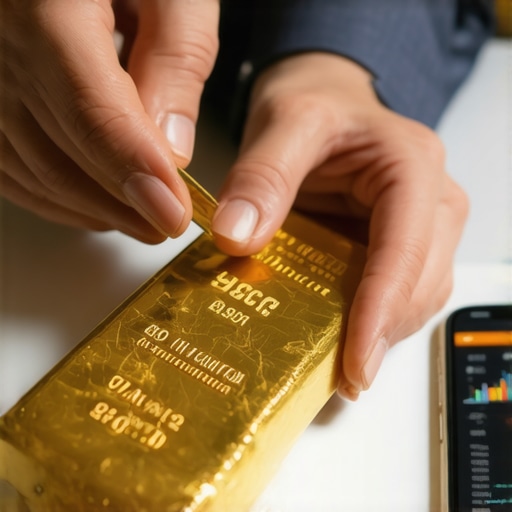Understanding the Value of Gold in Today’s Market
Investing in gold has become increasingly popular among both seasoned investors and those new to the financial world. The allure of gold lies in its historical significance as a store of value and a hedge against inflation. As uncertainties in the economy persist, many people are asking themselves, “Why should I buy gold now?” In this practical guide, we will explore key reasons to invest in gold and provide tips for first-time investors looking to navigate this exciting market.
The Advantages of Investing in Gold
Gold offers several advantages that make it an attractive investment option. First and foremost, it serves as a reliable hedge against inflation. When currencies lose value, gold tends to hold its worth, making it a safe haven during economic downturns. Additionally, gold is a tangible asset that has intrinsic value, unlike stocks or bonds that can fluctuate dramatically based on market trends.
Moreover, investing in gold can enhance your investment portfolio. Diversification is a fundamental principle of investing, and adding gold can reduce overall risk. As a non-correlated asset, gold often performs well when other investments falter, providing stability during turbulent times.
Types of Gold Investments to Consider
For first-time investors, it’s essential to understand the various forms of gold investments available. You can choose to invest in physical gold, such as coins and bullion, or opt for more modern alternatives like gold ETFs (Exchange-Traded Funds) and gold mining stocks. Each option has its own set of advantages and disadvantages.
Physical Gold
Purchasing physical gold, such as bars and coins, offers the benefit of tangible ownership. However, it also requires secure storage and insurance. For many, the security and peace of mind that come with holding gold in their hands outweigh the logistical challenges.
Gold ETFs and Mining Stocks
Gold ETFs allow investors to buy shares that represent a certain amount of gold, making it easy to trade without the need for physical storage. Similarly, investing in gold mining stocks can provide exposure to gold prices while also offering potential dividends. However, mining stocks can be subject to company-specific risks, making them a less straightforward investment.
Key Considerations Before Buying Gold
As you consider purchasing gold, it’s vital to evaluate your financial goals and risk tolerance. Determine how much of your portfolio you want to allocate to gold and research the current market trends. For instance, understanding gold price trends can significantly influence your buying decision.
Additionally, stay informed about the factors driving gold prices, such as geopolitical events and economic indicators. Keeping abreast of these elements can help you time your investments effectively.
In conclusion, as you embark on your journey to invest in gold, remember to conduct thorough research and consider your investment strategy carefully. With the right approach, buying gold can be a rewarding venture that enhances your financial security and diversifies your investment portfolio.
Evaluating Gold Market Trends
Understanding the market trends is crucial when deciding to buy gold now. Investors should keep a close eye on historical price movements and current market conditions. Analyzing factors such as inflation rates, interest rates, and global economic stability can provide insights into potential price fluctuations. For those keen on making informed decisions, delving into gold price trends is essential.
Timing Your Gold Investments
Timing can significantly impact your investment returns. Many seasoned investors recommend buying gold during dips in price to maximize potential gains. Additionally, observing seasonal trends in gold prices can inform your timing. For instance, gold prices often increase during times of economic uncertainty, such as geopolitical tensions or financial crises. Staying updated on navigating gold price trends can help you identify these opportunities.
Long-term vs. Short-term Strategies
When investing in gold, consider whether your strategy is long-term or short-term. Long-term investors may focus on the overall value of gold as a hedge against inflation and a safe haven asset. In contrast, short-term traders might capitalize on price fluctuations using more active trading strategies. Understanding whether to adopt a long-term perspective or a more dynamic approach can shape your investment decisions.
Storage and Security Considerations
One of the practical aspects of investing in physical gold is storage and security. Physical gold requires safe storage, which can include home safes or professional vault services. Each option comes with its own costs and risks. For instance, while home safes offer convenience, they may not provide the same level of security as a professional vault. It’s important to weigh the benefits and drawbacks of physical gold storage to ensure your investment remains secure.
Understanding Gold Investment Costs
Investing in gold is not just about the purchase price; other costs can significantly impact your overall returns. Make sure to account for premiums, storage fees, and insurance costs when calculating your potential investment. Additionally, if you’re considering gold ETFs or mining stocks, be aware of management fees and trading commissions. Understanding these costs can be pivotal in optimizing your gold investment strategies.
Tax Implications of Gold Investments
It’s vital to understand the tax implications associated with gold investments. Depending on your jurisdiction, gold can be treated as a collectible, subjecting it to higher capital gains tax rates. Consulting with a tax professional can help clarify these implications and inform your investment strategy. Being aware of potential tax liabilities ensures you have a comprehensive view of your investment returns.
Finding a Reliable Dealer
Choosing a reputable dealer is crucial for ensuring you obtain genuine gold at fair prices. Research potential dealers thoroughly, read reviews, and verify their credentials before making a purchase. Look for dealers who are members of recognized industry associations, which can provide a degree of assurance about their business practices. Additionally, understanding how to buy gold bullion from trusted sources can enhance your confidence as a buyer.
As you continue your journey into gold investment, the next steps involve not only making informed decisions but also understanding how to navigate the complexities of the gold market effectively.
Advanced Strategies for Investing in Gold
As you deepen your understanding of gold investments, exploring advanced strategies can enhance your potential returns. Many investors look beyond simply buying gold to include strategies that incorporate market analysis and timing. A thorough grasp of gold market dynamics can significantly improve your investment outcomes.
Utilizing Technical Analysis in Gold Trading
Technical analysis is a powerful tool for investors looking to buy gold at optimal times. By studying historical price charts and patterns, you can identify potential trends and reversals. For example, recognizing support and resistance levels can inform your entry and exit points. Incorporating tools such as moving averages and relative strength indicators can also help forecast future price movements, allowing you to make more informed trading decisions.
Understanding Gold Futures and Options
Another advanced investment avenue is through gold futures and options. These financial derivatives allow you to speculate on the future price of gold without requiring physical ownership. Gold futures contracts obligate you to buy or sell at a predetermined price on a specified date, presenting opportunities for significant gains. However, they also come with increased risks, including the potential for substantial losses. Therefore, understanding how to navigate these instruments is crucial for success.
Exploring Global Economic Indicators
Investing in gold also requires a keen awareness of global economic indicators that can influence gold prices. Factors such as changes in interest rates, inflation data, and geopolitical events can lead to price fluctuations. For instance, when central banks signal a potential interest rate hike, it may strengthen the dollar and negatively impact gold prices. Conversely, economic instability often drives investors toward gold as a safe haven, boosting demand and prices. Keeping abreast of these indicators can help you better time your investments and adjust your strategy accordingly.
Gold Investment in Different Economic Conditions
Understanding how gold performs in various economic conditions is vital for strategic investing. During inflationary periods, gold typically retains its value, making it an effective hedge. In contrast, during economic growth phases, investors may prefer equities, leading to a dip in gold prices. Knowing when to pivot your strategy based on economic conditions can maximize your returns. For further insights on this topic, refer to gold price trends.
Staying Updated with Gold Market News
To make informed decisions, staying updated on news and developments affecting the gold market is essential. Subscribe to financial news outlets and follow reputable analysts who specialize in commodities. Engaging with communities on platforms like forums and social media can also provide real-time insights into market sentiment. By maintaining a pulse on current events, you can adjust your strategies proactively and capitalize on emerging opportunities.
Diversifying Within Gold Investments
Diversification is key to managing risk in any investment portfolio. Within gold investments, consider diversifying across different forms such as bullion, coins, ETFs, and mining stocks. Each type comes with its own risk profile and potential return, so spreading your investments can enhance your overall performance. For tips on balancing your portfolio, explore the role of gold in a diverse investment portfolio.
Understanding Gold’s Correlation with Other Assets
Finally, grasping the correlation between gold and other asset classes can inform your investment strategy. Gold often moves inversely to the stock market and can act as a hedge during market downturns. Monitoring this relationship can help you time your trades effectively. For example, when stock markets are volatile, increasing your gold holdings might offer protection against losses.
Leveraging Market Analysis for Better Gold Investments
In the competitive landscape of gold investing, leveraging market analysis is essential for making informed decisions. Understanding market cycles and price fluctuations can significantly impact your investment strategy. By utilizing both fundamental and technical analysis, you can gain insights into potential price movements and optimize your buying and selling decisions.
Fundamental Analysis in Gold Investing
Fundamental analysis involves evaluating economic indicators that can influence gold prices. Key factors such as inflation rates, interest rates, and geopolitical stability play critical roles in determining gold’s market behavior. For example, rising inflation typically increases demand for gold as a hedge, driving prices up. Investors should stay informed about these economic indicators to assess the right timing for their investments. For a comprehensive overview, check out understanding gold price influences.
Technical Analysis Tools
On the other hand, technical analysis relies on historical price data and chart patterns to forecast future movements. Investors can use tools like moving averages, Relative Strength Index (RSI), and Fibonacci retracement levels to identify trends and reversals. For instance, if gold is consistently bouncing off a certain price level, it might indicate a strong support level, making it an opportune time to buy. Understanding these tools can enhance your trading strategies, helping you make timely decisions.
Investing in Gold Mining Stocks
Investing in gold mining stocks can offer substantial returns, especially when gold prices are on the rise. These stocks tend to have a leveraged connection to gold prices, meaning they can increase in value at a faster rate than gold itself. However, they also come with unique risks, such as operational inefficiencies and regulatory challenges. Therefore, it’s crucial to conduct thorough research on mining companies, their financial health, and production capabilities. For more insights, explore successful investing in gold mining stocks.
Understanding Gold ETFs
Gold ETFs (Exchange-Traded Funds) provide a convenient way to invest in gold without needing to purchase physical assets. They trade like stocks on exchanges, making them easy to buy and sell. ETFs hold physical gold or gold-related assets, allowing investors to gain exposure to gold prices without the complexities of storage and security. However, it’s essential to compare different ETFs based on their management fees, liquidity, and performance history. For a detailed guide on choosing the right ETF, refer to navigating gold ETFs.
Exploring Gold Futures for Experienced Investors
For more experienced investors, gold futures can be an exciting avenue. These contracts allow you to agree to buy or sell gold at a predetermined price at a future date. While they offer the potential for significant profits, they also come with high risks. Understanding the mechanics of futures trading and the factors influencing price movements is crucial before venturing into this market. If you’re interested in futures, consider reading a beginners guide to investing in gold futures.
Conclusion: Staying Ahead in Gold Investment
As you delve deeper into gold investments, it’s vital to stay informed and adaptable. The gold market is influenced by various factors, and maintaining a flexible investment strategy can enhance your potential for success. By utilizing both fundamental and technical analysis, diversifying your investments, and keeping abreast of market conditions, you can navigate the complexities of gold investing and make sound decisions that align with your financial goals.
Frequently Asked Questions About Gold Investment
1. Why should I consider investing in gold now?
Investing in gold is particularly appealing during economic uncertainty, as it acts as a hedge against inflation and currency fluctuations. With current market volatility, many investors seek gold to stabilize their portfolios.
2. What are the different types of gold investments available?
Investors can choose between physical gold (like coins and bullion), gold ETFs (Exchange-Traded Funds), and gold mining stocks. Each option has unique benefits and risks, catering to different investment strategies.
3. How can I determine the right time to buy gold?
Timing your gold purchases involves analyzing market trends, geopolitical events, and economic indicators. Many investors look for price dips or increased demand during economic instability as optimal buying opportunities.
4. What are the risks associated with investing in gold?
While gold is a safe-haven asset, it is not risk-free. Potential risks include price volatility, storage and security challenges for physical gold, and company-specific risks when investing in gold mining stocks.
5. Are there tax implications when investing in gold?
Yes, the tax treatment of gold investments can vary based on your location. Gold may be classified as a collectible, leading to higher capital gains tax rates. Consulting a tax professional can provide clarity on your obligations.
6. How do I choose a reputable gold dealer?
To find a reliable dealer, conduct thorough research, read customer reviews, and verify credentials. Look for dealers affiliated with recognized industry associations to ensure fair practices and genuine products.
7. What are gold ETFs, and how do they work?
Gold ETFs are investment funds that hold physical gold or gold-related assets. They trade like stocks, providing a convenient way for investors to gain exposure to gold prices without the need to manage physical assets.
8. Can I invest in gold futures and options?
Yes, gold futures and options are available for experienced investors looking to speculate on gold price movements. However, these financial instruments come with higher risks and require a solid understanding of market dynamics.
9. How does gold perform in different economic conditions?
Gold typically retains its value during inflationary periods and economic downturns, making it a reliable investment. Conversely, during economic growth, investor preference may shift towards equities, impacting gold prices.
10. What are the benefits of diversifying within gold investments?
Diversifying across various forms of gold investments, such as bullion, coins, ETFs, and mining stocks, can help mitigate risks and enhance overall portfolio performance, as different types respond differently to market conditions.
Authority Resources for Gold Investment
To enhance your knowledge and make informed decisions about gold investments, consider the following trusted resources:
- Kitco – A leading source for precious metals information, including live prices and market news.
- World Gold Council – Provides comprehensive data on gold demand, supply, and investment opportunities.
- Investopedia – Offers educational articles on investing, including guides on gold and precious metals.
- MarketWatch – Delivers financial news and analysis, including updates on gold prices and market trends.
- CNBC – Features news related to global financial markets, including gold investment insights.
Conclusion: Navigating Your Gold Investment Journey
In conclusion, investing in gold presents a myriad of opportunities and considerations. By understanding market trends, evaluating your investment strategy, and using reliable resources, you can enhance your financial security and portfolio diversification. Whether you choose to buy physical gold, invest in gold ETFs, or explore mining stocks, staying informed is key to making wise investment decisions. As you contemplate your next moves, remember that with careful planning and research, you can successfully navigate the gold market and seize the potential it offers.










This guide really emphasizes the importance of diversifying your gold investments, which I totally agree with. When I first started investing in gold, I focused solely on physical coins, but I soon realized that combining it with ETFs and mining stocks gave me a better balance of risk and opportunity. One thing that struck me, though, was the importance of secure storage for physical gold—it’s both a practical and emotional consideration. I’ve used professional vaults and feel much more at ease knowing my gold is protected. What strategies have others found effective for safeguarding their physical gold assets? Are there particular vault providers or insurance options that have worked well? Joining a community of investors or consulting with financial advisors can really help refine these choices, especially as markets fluctuate. It’s fascinating how the gold market continuously evolves, and staying informed on market trends and security measures has helped me make smarter, more confident decisions—it sounds like a lot of seasoned investors stay on top of these factors to safeguard their investments effectively.